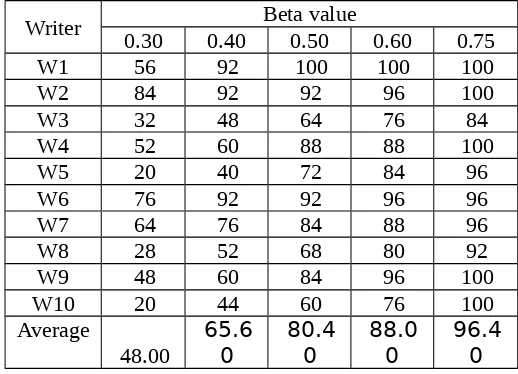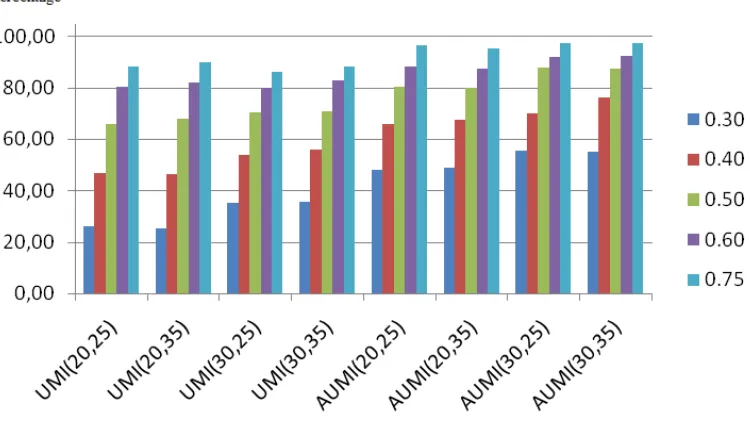WRITER INDENTIFICATION BASED ON HYPER SAUSAGE
NE-URON
Samsuryadi
1, and Siti Mariyam Shamsuddin
2 1Informatic Engineering Universitas Sriwijaya, Indonesia, syamsuryadi@unsri.ac.id2Universiti Teknologi Malaysia, Malaysia, mariyam@utm.my
ABSTRACT. This paper proposes biomimetic pattern recognition (BPR) based on hyper sausage neuron (HSN) and applies it in writer identification. HSN is used to cover the training set. HSN’s coverage can be seen as a topo-logical product of a one-dimensional line segment and an n-dimensional su-persphere. The feature extraction is moment invariants such as united mo-ment invariants (UMI) and aspect united momo-ment invariants (AUMI). The experiments result show that AUMI-HSN method is more effective than UMI-HSN method for identifying the authorship of handwriting.
Keywords: biomimetic pattern recognition, hyper sausage neuron, writer identification, united moment invariants, aspect united moment invariants
INTRODUCTION
Research on handwriting analysis based on the identification of the author's point of view in the last ten years experienced a significant development, particularly in forensic applica-tions. A writer identification system aims to search a document legal ownership of a person against a large database with a sample of the author's handwriting recognition (Bulacu & Sc-homaker, 2007). Special image-making is done based on the features captured from each indi-vidual's handwriting. The final decision made by forensic experts to determine the identity of the author sample in question.
One of the problems of identification for purposes of the authors often appear in the court of justice in determining whether a conclusion about the authenticity of the document. This also applies in some institutions that analyze the text of former writers, and identification of various authors who took part in the preparation of the manuscript. The significant results from recent years in the field of handwriting recognition makes it possible to bring this signif-icant answers to specific problems.
At this time, many researchers have used statistical decision model in identify the writer from the handwriting samples. Pattern classification used to determine the pattern without us-ing some previous knowledge of the relationship between the samples in the same class. This differs from the human function.
This paper focuses on hyper sausage neuron (HSN) for writer identification. Firstly, some handwritings are extracted through united moment invariant (UMI) (Yinan, et. al., 2003) and aspect united moment invariant (AUMI) techniques (Muda, et. al., 2008). Secondly, HSN classifier is used to identify the features obtained at the first step. The experiments of writer identification is implemented to demonstrate learning ability and the correct rate of AUMI-HSN and UMI-AUMI-HSN methods.
WRITE IDENTIFICATION BASED ON HSN Biomimetic Pattern Recognition (BPR)
In the real world, every one finds one by one similarity between things in the same class. If there are two samples belong to the same class, the differences between them should gradu-ally change. So there must be a sequence of gradual changes between the two samples. Prin-ciple of continuity between homologous samples in feature space is called the prinPrin-ciple of ho-mology-continuity (PHC) (Shoujue & Xingtao, 2004). PHC can be described in mathematical formulas: suppose that point set A includes all samples in the class A in feature space. If It is a kind of prior knowledge of sample distribution in the BPR to improve the cognitive ability, then BPR intends to find the optimal covering of samples in the same class. The basic step of BPR is to analyze the relation between training samples of the same class in the fea-ture space, which is made possible through the PHC of sample distribution (Jiang, at. al., 2009).
Cover Neuron
HSN is as the basic covering unit of the training set. HSN’s coverage in high dimensional space, which constructs a sausage like shape in feature space for covering the distribution area of the sampling points in the same class, (Shoujue & Xingtao, 2004). The HSN covering can be seen as a topological product of a one-dimensional line segment and an two-dimensional supersphere (Xu & Wu, 2010).
Cover process
Let A{A1,A2,...,An}, is the samples points of the training set and one sample deno-tedAi (ai1,ai2,...,ail), where i1,2,...,n and l is dimension of the feature space or number of features.
The construction steps of HSN for writer identification are as follows:
Step 1. Calculate the Euclid distance every two points in the A,find two points with the
Step 2. Let U1 S {B11,B12}. Find point in U1is the nearest toB12,denoted as B13
The above algorithm is terminated, if all the points in
A
have been
covered.Finally we have (n-1) HSNs, and the covering area of training samples in this case is
the
union set of the areas by these neurons:
1Calculated eachifor A. Finally the testing sample
A
would be classified to the classwhich corresponding to the least i namely,
RESULT AND DISCUSSION
In this paper, the handwriting data are obtained from IAM database (Marti & Bun-ke, 2002). We choose 10 persons with 10 words were selected and each word was made for 10 times (all 1000 samples). We use two feature extraction methods such as united mo-ment invariants (UMI) and aspect united momo-ment invariants (AUMI) to show that BPR is not relied on certain feature extraction method.
For each of 10 persons (writer) has 20 training samples (4 words x 5 repetition), and 25 testing samples (5 words x 5 repetition). Each training samples is used to training the neurons of BPR model for each class, thus each cover set of the 10 persons has 19 HSNs. The experi -ment result in percentage for beta value 0.30 as far as 0.75 can be showed in Table 1.
Table 1. Percentage Result for Each Writer and Beta Value Based on AUMI-HSN
Writer Beta value
0.30 0.40 0.50 0.60 0.75 W1 56 92 100 100 100 W2 84 92 92 96 100 W3 32 48 64 76 84 W4 52 60 88 88 100 W5 20 40 72 84 96 W6 76 92 92 96 96 W7 64 76 84 88 96 W8 28 52 68 80 92 W9 48 60 84 96 100 W10 20 44 60 76 100 Average
48.00
65.6 0
80.4 0
88.0 0
96.4 0
Based on Table 1, W1 with beta value 0.30 can be identified 14 samples from 25 samples (56%), 92% (23/25) for beta value 0.40, and so on. The best average result of identifying writer from 10 writers in beta value 0.75 is 96.40%. We can see beta value has influence to identify the authorship of handwriting.
We do the same way for UMI-HSN with 10 writers, 20 training samples and 25 testing samples and the best average result in beta value 0.75 is 88.00%, detail result shows in Table 2.
Table 2. Percentage Result for Each Writer and Beta Value Based on UMI-HSN
Writer 0.30 0.40 Beta value0.50 0.60 0.75 W1 24 64 80 96 96
W2 36 48 84 96 96
W3 8 20 32 76 88
W4 32 72 80 84 88
W5 24 36 64 76 84
W6 0 4 20 28 40
W7 40 48 56 68 88
W8 32 48 84 92 100
W9 32 84 92 100 100
W10 32 44 64 88 100
Besides experiment above, we do the other training samples and testing samples to show the performance of the method. For instance, UMI(30,35) means 30 training samples and 35 testing samples for feature extraction, UMI and classification method, HSN (UMI-HSN) for beta values from 0.30 to 0.75. The complete result can be showed in Figure 1.
Figure 1. Bar Chart for UMI-HSN vs AUMI-HSN Based on Beta Values
Based on Figure 1, we make difference percentage correct rate between UMI-HSN method and AUMI-HSN method for beta values 0.75 as Table 3.
Table 3. The percentage matches the identification with UMI-HSN and AUMI-HSN Data Correct rate (%)
Training
Samples SamplesTesting UMI-HSN AUMI-HSN 20 25 88.00 96.40 30 25 86.00 97.20 20 35 89.71 95.14 30 35 88.00 97.14
CONCLUSION AND FUTURE WORK
This paper proposed AUMI-HSN and UMI-HSN for identifying the authorship of handw-riting. The experiments result showed that AUMI-HSN method was better than UMI-HSN method, the correct rate UMI-HSN was around 88% and AUMI-HSN was around 96%. Futu-re work can be conducted to further exploFutu-re the moment invariants featuFutu-re extraction methods and cover neurons appropriate for BPR.
REFERENCES
Bulacu, M., & Schomaker, L. (2007). Text-Independent writer identification and verification using textural and allographic features. IEEE Transactions on Pattern Analysis and Ma-chine Intelligence, Vol. 29, No. 4.
Jiang, J., Wei, H., & Qi, Q. (2009). Medical image segmentation based on biomimetic pattern recognition. World Congress on Software Engineering, 375-379.
Marti, U.-V., & Bunke, H. (2002). The IAM-database: an english sentence database for off-line handwriting recognition. International Journal on Document Analysis and Recog-nition, 39-46, Vol. 5.
Muda, A. K., Shamsuddin, S.M., & Darus, M. (2008). Discretization of integrated moment in-variants for writer identification. Proceedings of the Fourth IASTED International Conferen-ce AdvanConferen-ces in Computer ScienConferen-ce and Technology (ACST 2008), 372-377, Langkawi, Malaysia. ISBN: 978-0-88986-730-7.
Samsuryadi, & Shamsuddin, S.M. (2010). A framework of biomimetic pattern recognition in writer identification. Proceedings of International Seminar of Information Technoloy (ISIT 2010), 168-173, Bandung, Indonesia. ISBN: 978-602-97962-0-9.
Shoujue, W. (2003). A new development on ANN in China – biomimetic pattern recognition and multi weight vector neurons. Lecture Notes in Computer Science, 35-43. Springer Verlag.
Shoujue, W., & Xingtao, Z. (2004). Biomimetic pattern recognition Theory and Its Applica-tions. Chinese Journal of Electronics, 373-377, Vo1. 13, No. 3.
Xu, K., & Wu, Y. (2010). Motor imagery EEG recognition based on biomimetic pattern re-cognition. Proceedings of BMEI 2010, 3th International Conference on Biomedical Engineering and Informatics, 955-959.

